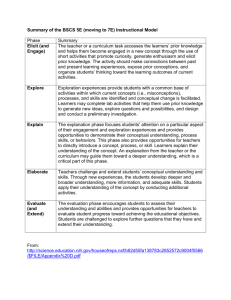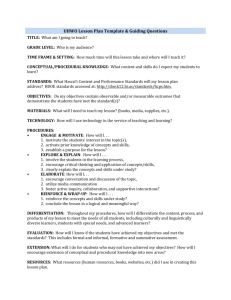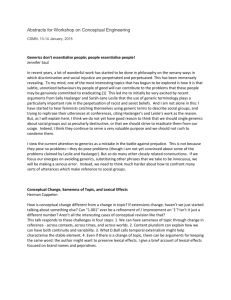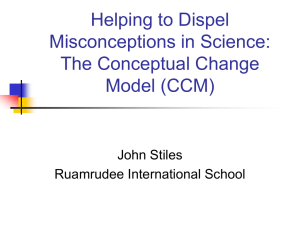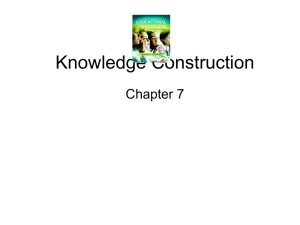My Summary of The Articel
advertisement
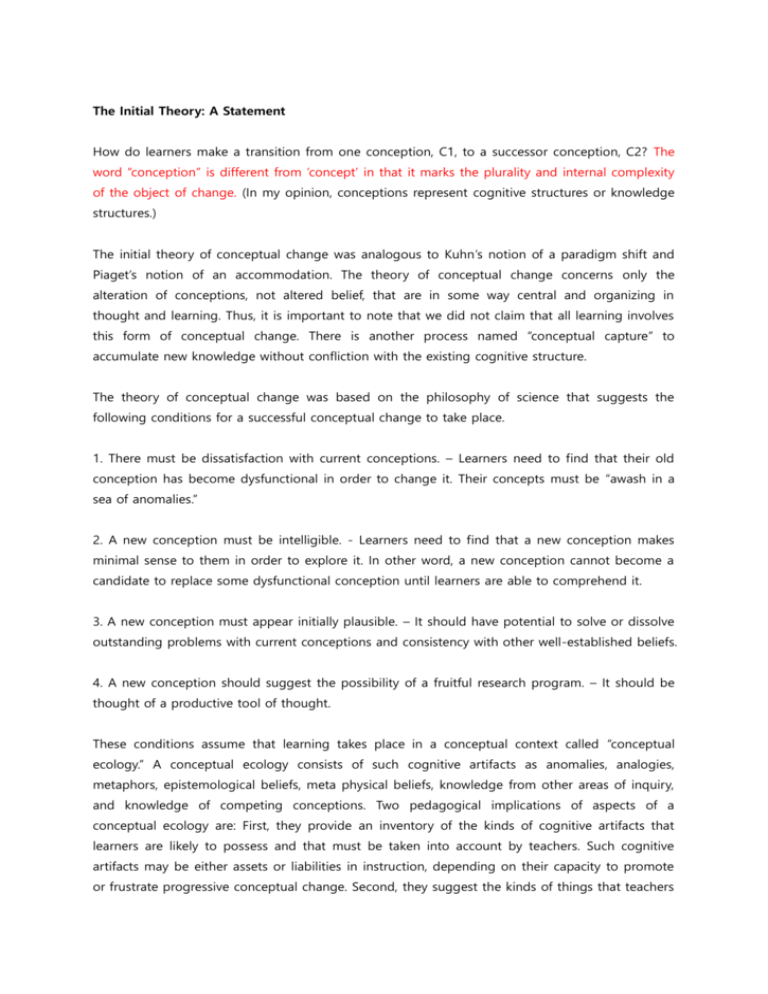
The Initial Theory: A Statement How do learners make a transition from one conception, C1, to a successor conception, C2? The word “conception” is different from ‘concept’ in that it marks the plurality and internal complexity of the object of change. (In my opinion, conceptions represent cognitive structures or knowledge structures.) The initial theory of conceptual change was analogous to Kuhn’s notion of a paradigm shift and Piaget’s notion of an accommodation. The theory of conceptual change concerns only the alteration of conceptions, not altered belief, that are in some way central and organizing in thought and learning. Thus, it is important to note that we did not claim that all learning involves this form of conceptual change. There is another process named “conceptual capture” to accumulate new knowledge without confliction with the existing cognitive structure. The theory of conceptual change was based on the philosophy of science that suggests the following conditions for a successful conceptual change to take place. 1. There must be dissatisfaction with current conceptions. – Learners need to find that their old conception has become dysfunctional in order to change it. Their concepts must be “awash in a sea of anomalies.” 2. A new conception must be intelligible. - Learners need to find that a new conception makes minimal sense to them in order to explore it. In other word, a new conception cannot become a candidate to replace some dysfunctional conception until learners are able to comprehend it. 3. A new conception must appear initially plausible. – It should have potential to solve or dissolve outstanding problems with current conceptions and consistency with other well-established beliefs. 4. A new conception should suggest the possibility of a fruitful research program. – It should be thought of a productive tool of thought. These conditions assume that learning takes place in a conceptual context called “conceptual ecology.” A conceptual ecology consists of such cognitive artifacts as anomalies, analogies, metaphors, epistemological beliefs, meta physical beliefs, knowledge from other areas of inquiry, and knowledge of competing conceptions. Two pedagogical implications of aspects of a conceptual ecology are: First, they provide an inventory of the kinds of cognitive artifacts that learners are likely to possess and that must be taken into account by teachers. Such cognitive artifacts may be either assets or liabilities in instruction, depending on their capacity to promote or frustrate progressive conceptual change. Second, they suggest the kinds of things that teachers may provide in instruction in order to facilitate conceptual change. Background Commitments of the Theory The initial formulation of our theory is not grounded in any experimental evidence and is not a general theory of cognitive development. Our theory points out that evidence from philosophy and history of science are relevant to major conceptual revisions. In addition, this theory suggests that the basic problem of understanding cognitive development is to understand how the components of an individual’s conceptual ecology interact and develop and how the conceptual ecology interacts with experience. Epistemological theory: Our main concern is the formation of rational belief. Epistemology seeks to specify the logical parameters of rational belief. In other word, its chief task is to specify criteria that enable us to distinguish true or reasonable beliefs from false or unreasonable ones. We have been substantially influenced by those theories of rationality that have been developed by authors such as Kuhn, Toulmin, and Lakatos. What these authors have in common is a regard for the history of science and the practice of science as sources of information about the nature of rationality. More recent work in philosophy of science has emphasized the role of substantive belief in scientific reasoning and method. Scientific reasoning is generated not only by formal logic but also by substantive belief system such as Kuhn’s paradigm or Lakatos’ research programs. These substantive belief systems (substantive conceptions) suggest what are to count as problems and what is to count as relevant evidence. Indeed, they provide the perceptual categories by which the world is perceived. An argument for a given scientific conceptions is never merely stated as a logical relationship between a set of theoretical claims and a set of unconceptualized observations. Instead, scientific arguments must be framed against the background of current conceptions. Thus, arguments are historically conditioned. What counts as evidence at a given period depends on what is currently believed. Descriptions of scientific method are similarly historically conditioned and must be formulated by historical and logical investigation. However, the preoccupation with rational belief may generate blind spots. One thing to consider is that learners are not likely to be as rational as scientists. The major modifications required are to take into account the immaturity and novice standing of the learner and to de-emphasize those aspects of the sociology of scientific communities that have figured I the philosophical theories of conceptual change. Misconceptions research: Our views of epistemology can be applied to the explanations of misconception: why conceptual change should take place in learning; why misconceptions are resistant to change. A misconception is nor merely a mistake or a false belief. Either it must also play the kind of organizing role in cognition that paradigm play, or it must be dependent on such organizing concepts. A misconception, thus, may become a candidate for change. The theory of conceptual change provides an account of how such change may be brought about. One of the most important findings of the misconceptions literature is that misconceptions are highly resistant to change. The philosophical literature on conceptual change in science, especially Kuhn’s work, provides the rudiments of both an epistemological and a sociological account of why this might be so. The epistemological account provides a view of how paradigms are maintained that is readily applied to misconceptions. This account turns on how some concepts are connected to others, how they function in thought, and how they structure perception. Kuhn’s work explain why the reappraisal of one concept will require the reappraisal and modification of others and why some conceptions will be quite resistant to change, if they are embedded in a web of other concepts that lend them plausibility or intelligibility. When a misconception is firmly embedded in a conceptual context, the cost required for its revision is high. Students will have to alter other concepts as well. Moreover, unless these other concepts are altered, they will continue to maintain the misconception. In effect, conceptions often come with their own cognitive support group. They will resist modification so long as this support group continues to play its role. For the origins of misconceptions, while some authors (e.g., McCloskey) believe that they are generated by misperceiving the world, we think that they are generated and maintained by other concepts in a student’s conceptual ecology. Moreover, the fact that students misperceive the world is seen as a phenomenon in need of an account. Critique of the Theory The theory was based on the assumption that learners have well-articulated conceptions about most topics. The assumption that misconceptions or prior conceptions are clearly articulated and expressly and symbolically formulated is doubtful in two different respects. First, it seems entirely possible that misconceptions, especially those of younger or novice learners, exist in either iconic or inactive forms of representations. They may have just “intuitions” about how something works. Second, misconceptions have developmental histories. They are generated by various factors in a conceptual ecology. Those factors function to select for or prefer some representation of a misconception when the opportunity to do so exists. For example, a student doesn’t have any idea about moving object, but when he was asked, he uses the images and way of talking about moving objects that can lead him to answer with a misconception that forces are transferred to objects and erode during motion. Those images and way of talking provide a context for one’s judgment about how something works. Therefore, what is most important in instruction is understanding the factors in learners’ conceptual ecologies that generate and maintain misconceptions. These factors can account for both the durability of misconceptions and their commonalities across learners and even sometimes cultures. We emphasized initially the importance of creating dissatisfaction with current conceptions, but this emphasis is appropriate only when misconceptions are highly articulated like a paradigm. If the factors in conceptual ecology are the causes of misconceptions, we had better root out the factors and replace them with more felicitous concepts. In sum, what requires is a focus on the learner’s conceptual ecology and how that ecology structures learning. The theory was too linear. The second assumption was that conceptions or misconceptions are cognitive object acted on by the conceptual ecology, but are not themselves part of it. Thus, we did not much attend to the ways in which conceptions or misconceptions interact with that ecology. However, scientific conceptions and misconceptions are also part of a conceptual ecology, and all the parts of a conceptual ecology must be seen as dynamic and in constant interaction and development. Current conceptions or misconceptions function to influence new perceptions or new ideas. We tend to perceive only the world that is consistent with our current conceptions and not attend to counter examples. Misconceptions may interact with current features of a conceptual ecology. The theory was overly rational. We underestimate the range of factors that might function as part of a conceptual ecology. The factors that we consider in the conceptual change were those logically relevant to appraising the worth of two competing scientific conceptions. We may rely too much on philosophy of science as a source of models of rationality. There are other factors that affect learners’ choices between two competing scientific conceptions. For example, for some learners the problem to be solved in the classroom is that of discovering how to get a good grade. In this case, they tend to become rote learners. For others, the problem may be discovering how to maintain self-esteem in the face of a subject that is unintelligible. Their response could be to devalue the subject matter. Or students may conceptualize the task as a piece of academic work instead of a scientific inquiry. In sum, other variables such as motivation and the view as to the nature and value of subject matter should be in an account of a conceptual ecology. These factors can affect the approach taken to a subject, the matter in which it is represented, and the conception of the subject matter developed. These effects, in turn, may influence further learning. Revisions Needed in the Initial Theory Five modifications required are as follows: 1. A wider range of factors needs to be taken into account in attempting to describe a learner’s conceptual ecology. Motives and goals and the institutional and social source of them need to be considered. The idea of a conceptual ecology thus needs to be larger than the epistemological factors suggested by the history and philosophy of science. 2. Current scientific conceptions and misconceptions are not only objects on which a learners’ conceptual ecology acts, they are themselves parts of the learner’s conceptual ecology. Thus they must be seen in interaction with other components. 3. Conceptions and misconceptions can exist in different modes of representation and different degrees of articulateness. They may not exist at all but may easily appear to do so, because under instruction or in research they are generated by other elements of a conceptual ecology. 4. A developmental view of conceptual ecologies is required. 5. An interactionist view of conceptual ecologies is required. Empirical Support for Revisions In the research, three items were asked to college students who have taken at least two semesters of college physics: epistemological view, qualitative physics, learning attitude. The results suggest the following. On the epistemological side they show a belief that the physical world is rational and a rejection of epistemological relativism both support and are supported by a growth in physics competence. On the side of our learning attitude items, they suggest that having confidence in one’s ability to understand physics, approaching learning as a matter of understanding the material instead of learning it by rote, and valuing learning science for its own sake tend to facilitate and are facilitated by growth in physics competence. However, one should be cautious about moving too quickly from the premise that some set of epistemological view or attitudes about learning facilitates the learning of science, to a conclusion that these views or attitudes are true and should be promoted. Treason is that empirical connection does not guarantee the truth. Further Research Needed Our conclusion suggests that the conceptual ecology that interact with instructions need to be described, that how they interact should be understood, and that the instructional strategies that interact in productive ways with the students current concepts need to be devised. For instructional purposes, we suggest three lines of inquiry. 1. There is a need for investigation of the sources of misconceptions prior to classroom instruction. 2. There is need to expand the account of a conceptual ecology, considering the attitudes that novices have toward the nature of science and scientific inquiry, and including the learner’s perceptions of the classroom task. 3. An account of how the students come to see the world as a rational place is needed.
